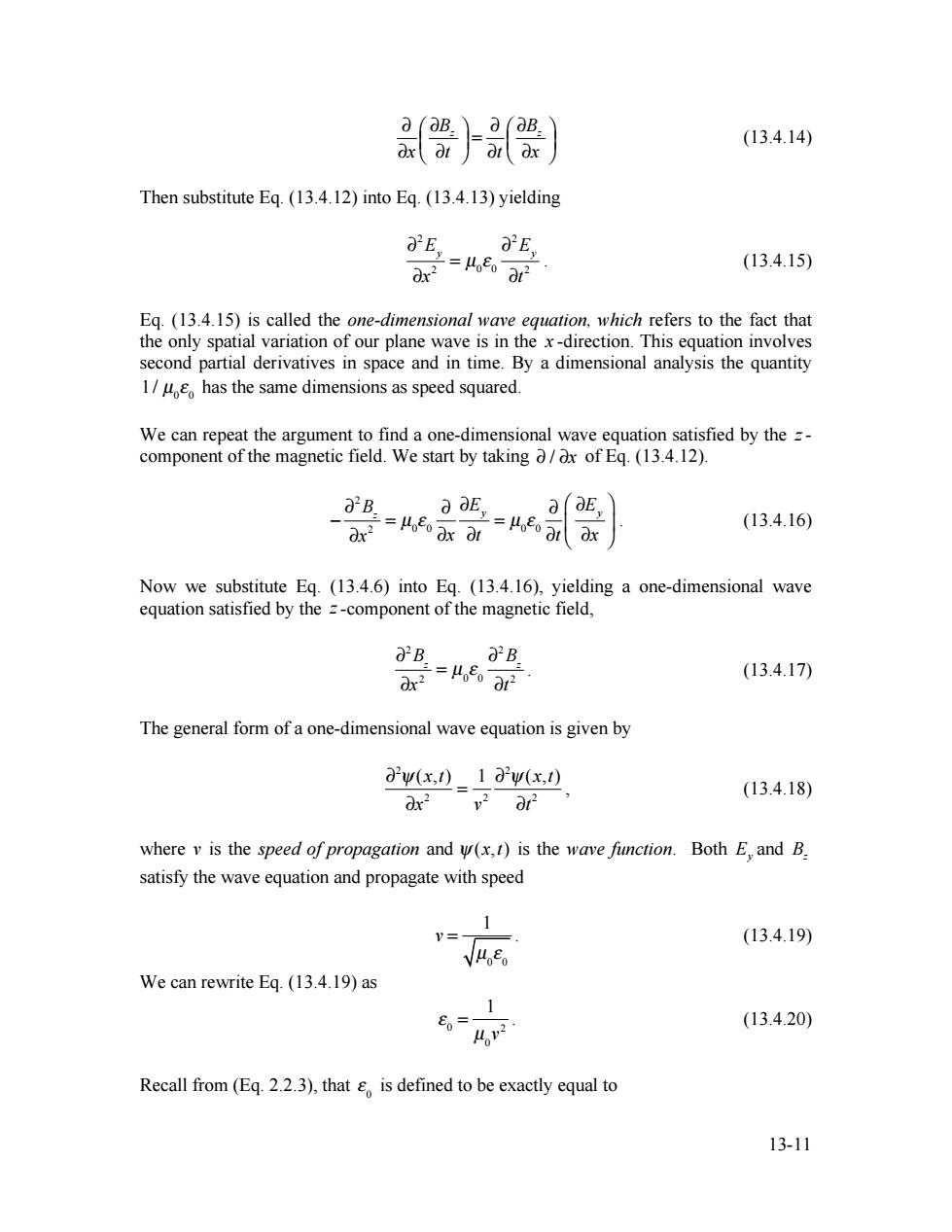正在加载图片...

aB. a(aB. (13.4.14) ax at Then substitute Eq.(13.4.12)into Eq.(13.4.13)yielding E. E, Hoo dt2 (13.4.15) Ox2 Eq.(13.4.15)is called the one-dimensional wave equation,which refers to the fact that the only spatial variation of our plane wave is in the x-direction.This equation involves second partial derivatives in space and in time.By a dimensional analysis the quantity 1/has the same dimensions as speed squared. We can repeat the argument to find a one-dimensional wave equation satisfied by the z- component of the magnetic field.We start by taking a/ax of Eq.(13.4.12) ad止y=ueo -=Hoo dx dt (13.4.16) dx Now we substitute Eq.(13.4.6)into Eq.(13.4.16),yielding a one-dimensional wave equation satisfied by the z-component of the magnetic field, B B. =00t dr2 (13.4.17) The general form of a one-dimensional wave equation is given by w(x,t)1 'w(x,t) (13.4.18) where v is the speed of propagation and y(x,t)is the wave function.Both E,and B. satisfy the wave equation and propagate with speed V= (13.4.19) uEo We can rewrite Eq.(13.4.19)as 1 Eo=- %2 (13.4.20) Recall from(Eq.2.2.3),that is defined to be exactly equal to 13-1113-11 Bz Bz x t t x ! " ! # ! " ! # $ % = $ % ! & ! ' ! & ! ' (13.4.14) Then substitute Eq. (13.4.12) into Eq. (13.4.13) yielding !2 E y !x 2 = µ0 " 0 !2 E y !t 2 . (13.4.15) Eq. (13.4.15) is called the one-dimensional wave equation, which refers to the fact that the only spatial variation of our plane wave is in the x -direction. This equation involves second partial derivatives in space and in time. By a dimensional analysis the quantity 1/ µ0 ! 0 has the same dimensions as speed squared. We can repeat the argument to find a one-dimensional wave equation satisfied by the zcomponent of the magnetic field. We start by taking ! / !x of Eq. (13.4.12). ! "2 Bz "x 2 = µ0 # 0 " "x "E y "t = µ0 # 0 " "t "E y "x $ % & ' ( ) . (13.4.16) Now we substitute Eq. (13.4.6) into Eq. (13.4.16), yielding a one-dimensional wave equation satisfied by the z-component of the magnetic field, !2 Bz !x 2 = µ0 " 0 !2 Bz !t 2 . (13.4.17) The general form of a one-dimensional wave equation is given by !2 "(x,t) !x 2 = 1 v 2 !2 "(x,t) !t 2 , (13.4.18) where v is the speed of propagation and ! (x,t) is the wave function. Both E y and Bz satisfy the wave equation and propagate with speed v = 1 µ0 ! 0 . (13.4.19) We can rewrite Eq. (13.4.19) as ! 0 = 1 µ0 v 2 . (13.4.20) Recall from (Eq. 2.2.3), that ! 0 is defined to be exactly equal to